German infantry anti-tank weapons (part 1)
German infantry first encountered tanks. The appearance of tracked armored monsters on the battlefield made a shocking impression on the German troops. September 15, 1916 18 British tanks of type Mark I during the battle on the Somme managed to break through the German defenses 5 km wide and advance 5 km inland. At the same time, the British losses in manpower during this offensive operation were 20 times less than usual. Due to the small number of tanks, their low technical reliability and low maneuverability, the further British advance was stalled, however, even the first clumsy, weakly armored combat vehicles showed their great potential, and the psychological impact on the German infantry was huge.
From the very beginning, the main means of fighting tanks became artillery. The armor of the first tanks was designed to protect against bullets rifle caliber and medium-sized fragments of shells of medium caliber. A direct hit of the 77-mm German fragmentation projectile in the 12 mm armor of the British tank Mark I, as a rule, led to its break. It soon became clear that shrapnel shells with a fuse, delivered to the blow, are even more effective. Quite good results in the fight against allied tanks were demonstrated by the 7.7 cm Infanteriegeschütz L / 20 and 7.7 trench guns cm Infanteriegeschütz L / 27, which were put into service in 1916 and in the 1917 year. For these guns special armor-piercing shells were created with an initial speed of 430 m / s and armor penetration to 30 mm. Also in the troops there was a significant amount of 75-mm Austrian guns Skoda 75 mm M15, which in the German army received the designation 7.5 cm GebK 15.
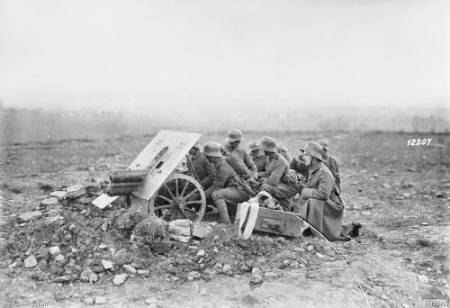
However, the German field and infantry guns, with a good rate of fire and a satisfactory range of a direct shot, had aiming devices that were unsuitable for shooting at mobile targets and a small sector of horizontal targeting. In addition, in the event of a breakthrough of tanks, quickly transferring guns transported by horse-drawn sleds to a new position was often problematic, in which case the German infantry was forced to use various improvised anti-tank weapons, such as bundles of grenades and drill drafts, which were thrown under the tracks of armored vehicles . Of the fragmentation grenades, the Stielhandgranate 15 was the most suitable for the ligaments, on the basis of which the well-known "beater" was subsequently created. However, it was impossible to solve the problem of fighting allied tanks with artisanal means, and at the final stage of the First World War in Germany they created a number of original anti-tank samples.
Calculations showed that for confident penetration of 15 mm armor at a distance of 300 m is required weapon caliber 12-14 mm with a mass of bullet 45-55 g and the initial speed 750-800 m / s. In 1917, the company Polta from Magdeburg developed the 13,25 × 92SR T-Gewehr cartridge.
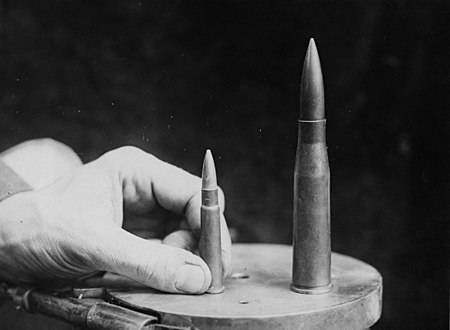
It was the world's first large-caliber rifle cartridge, specially designed to combat armored targets. With a sleeve length of 92 mm, its total length was 133 mm. Bullet weight - 52 d. Muzzle energy - 15400 J.
Under this cartridge, Mauser developed the Tankgewehr M1918 single-shot anti-tank rifle, which was put into service in the 1918 year. The PTR was recharged using a longitudinal slide valve with a turn. The new weapon actually was a single-shot Mauser 98 single rifle. The rifle had a wooden box with a pistol grip, in front of the box is mounted a bipod from the MG-08 / 15 machine gun.
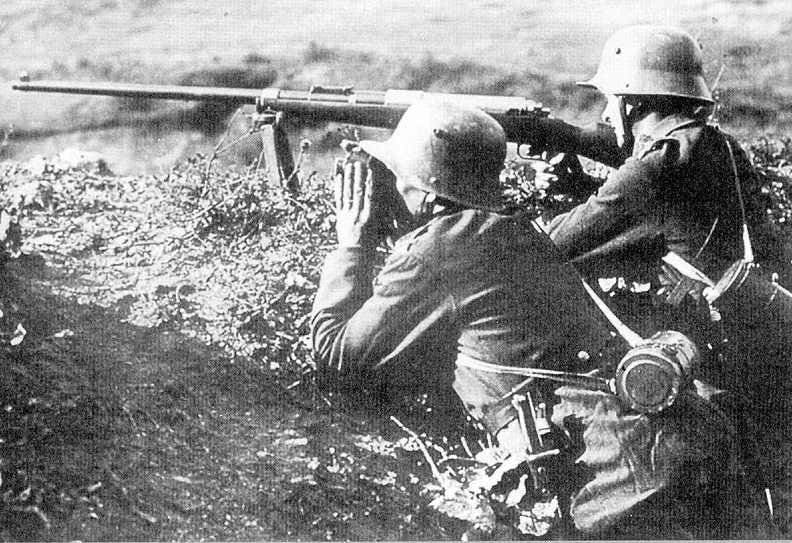
The weapon turned out quite bulky and heavy. The length of the anti-tank gun was 1680 mm, and the weight - 17,7 kg. But even with the large mass, the recoil when shooting was crushing for the shooter’s shoulder. Since the creators of the PTR did not bother installing the muzzle brake and damping the butt, the members of the calculation were forced to fire one by one. Ideally, the combat rate of fire could reach 10 rds / min, but in practice it was 5-6 rds / min. At a distance of 100 m in the normal 13,25-mm bullet pierced 20 mm armor plate, and on 300 m - 15 mm.
However, it soon became clear that it was not enough just to pierce the armor, it was necessary for the bullet to damage any vital unit inside the tank, to ignite fuel and lubricants, or to lead to the detonation of the ammunition. Since after the penetration of armor the energy of the bullet was small, there was little chance of that. And given the fact that the crew of the British "diamond-shaped" tanks were 7-8 people, the death or injury of one or two tankers, as a rule, did not lead to a stop of the tank. However, after the adoption of the Tankgewehr M1918 anti-tank guns and the mass saturation of the first-line units with them, the anti-tank capabilities of the German infantry increased significantly. In total, before the capitulation of Germany, more than 15000 anti-tank guns were fired, of which more than 4600 MFR were in front-line units.
New Zealand Marines pose with captured anti-tank gun, August 1918
After the end of the First World War, the Tankgewehr M1918 PTR was in service with several European states. Although Germany itself was forbidden to have anti-tank weapons, in the 30-ies in the Reichswehr there was more than 1000 PTR. After the Nazis came to power, 13,25-mm anti-tank guns were used to test promising samples of armored vehicles and for training purposes. In the USSR, in the second half of the 30-x, this weapon, converted to 12,7-mm cartridge DShK, was produced in small quantities for the needs of NIPSVO (scientific testing ground for small arms). In the initial period of the war in the workshops MVTU them. Bauman on the proposal of the engineer V.N. Sholokhov established an assembly of anti-tank guns, which differed from the German prototype by the presence of a muzzle brake, a shock absorber on the butt and another cartridge. According to the combat characteristics of the PTRSh-41, it corresponded to the Tankgewehr M1918, but it was a little easier and much more comfortable when shooting.
In addition to the anti-tank rifle chambered for 13,25 × 92SR T-Gewehr in Germany in 1918, Mauser’s specialists developed the MG 18 TuF heavy machine gun (Tank and Flieger Maschinengewehr), an anti-tank and anti-aircraft gun. Structurally, it was an enlarged machine 7,92-mm MG 08, which in turn was the German version of the Maxim machine gun. Machinenfabrik Augsburg-Nurnberg AG was supposed to build 13,25-mm machine guns.
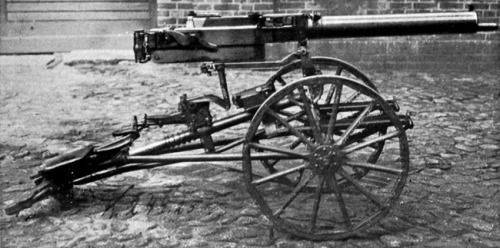
13,25-mm MG 18 TuF was the first large-caliber machine gun in the world. At the time of his creation, he was able to penetrate the armor of all British and French tanks without exception at the real distances of the battlefield, which theoretically made it possible to solve the problem of anti-tank combat. Since the barrel of the machine gun was somewhat longer than that of the same caliber PTR, he punched 100-mm armor at a distance of 22 m. Rate of fire - 300 rounds / min, combat rate of fire - 80 rounds / min. Although the mass of the machine gun mounted on the bulky wheeled carriage was 134 kg, and the machine gun crew included a 6 man, its combat characteristics as an anti-tank weapon and mobility were higher than those of field and infantry guns. However, with the number of 1918 units produced on 4000 planned for the year, only 50 machine guns could be assembled before the end of hostilities, and they had no effect on the course of the hostilities. The first bad experience with a large-caliber machine gun led to the fact that large-caliber machine guns were not developed in Germany for use by ground forces against armored vehicles and to combat low-altitude air targets.
Until the second half of the 30-s, Germany was deprived of the opportunity to legally create and adopt anti-tank weapons, and therefore weapons of this purpose were developed abroad, or underground in German design bureaus. In the initial period of the Second World War, the main anti-tank weapon of the regimental level in the Wehrmacht was the 37-mm PaK 35 / 36 guns. Like many other samples, a prototype anti-tank gun was secretly created at Rheinmetall in the 20s. This gun had a relatively low weight and was easily disguised on the ground. In 30-s, it was fully capable and could successfully fight with BT and T-26 tanks protected by anti-bullet armor. However, the experience of military operations in Spain has shown that in the event of a breakthrough of tanks to the leading edge, there is a need for anti-tank weapons of the battalion and company level. In this regard, at the end of 30-s in Germany, several samples of anti-tank guns were developed.

In order to reduce the mass of weapons and speed up the launch into mass production, the first German MFRs had a rifle caliber - 7,92-mm. To increase armor penetration, Guslov Werke developed a very powerful cartridge with a sleeve length of 94 mm (7,92 × 94 mm). On tests, after a shot from a barrel of length 1085 mm, a bullet weighing 14,58 g left it at a speed of 1210 m / s.
In 1938, the production of the 7,92-mm PTR Panzerbüchse 1938 (Russian Anti-Tank Gun), abbreviated to PzB 38, began at the Guslov Werke enterprise in Suhl. A single-shot anti-tank gun, developed by designer B. Brauer, had a moving barrel that, when fired, worked on the bolt. With the recoil energy, the coupled barrel and bolt shifted back in the stamped box, which at the same time served as the barrel cover. Due to this, the recoil decreased, and the shooter felt it weaker. This provided automatic ejection of the cartridge case and the opening of the shutter. After that, the next cartridge was loaded.
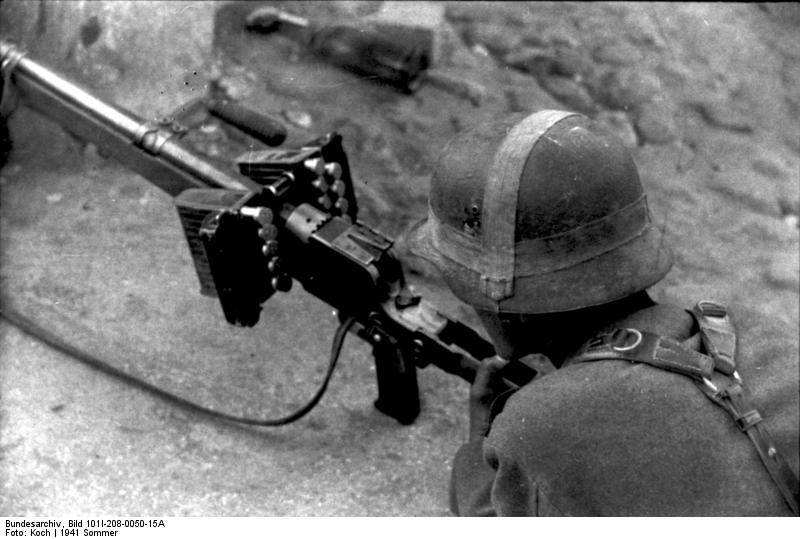
On both sides of the receiver could be mounted on top of the cassette with 10 spare cartridges in each - the so-called "loading accelerators." By reducing the time required to load the next cartridge, the combat rate of fire could reach 10 rds / min. Butt and bipod - folding. Sights were designed for a distance of 400 m.
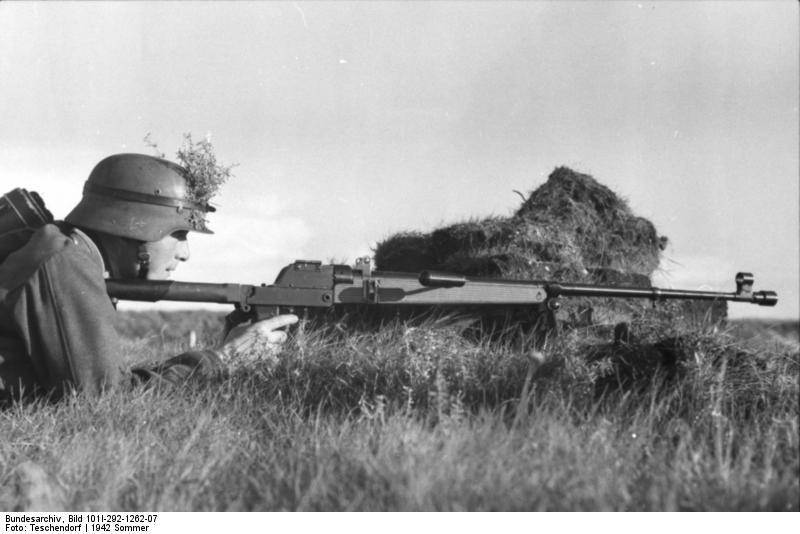
The anti-tank rifle PzB 38 despite the rifle caliber turned out weighty, its weight in the combat position was 16,2 kg. Length with butt spread out - 1615 mm. At a range of 100 m, when hit at right angles, penetration of 30 mm of armor was ensured, and at a distance of 300 m 25 mm of armor penetrated. From the outset, the developers of the 7,92-mm PTR were aware that their weapons would have extremely weak action. In this regard, the main ammunition was considered a cartridge with an armor-piercing bullet, in the head of which there was a hard-alloy core, and in the tail poison an irritant. However, due to the small amount of the active substance in the pool, the effect when a tear agent entered the interior of the reserve space was small. In 1940, production of armor-piercing cartridges with a tungsten carbide core of increased length began. This allowed to bring armor penetration to 35 mm at a distance of 100 m, while shooting at close range, 40 mm armor could be pierced. But in most cases, when the armor was broken through, the core crumbled into dust and the armor-like effect turned out to be very small. At best, one could hope for injury of the crew members of the tank, small pieces could not damage the internal equipment of the armored vehicle. In addition, the German defense industry has traditionally experienced an acute shortage of tungsten and cartridges with increased armor penetration are not widespread. But, despite the dubious combat effectiveness of the 7,92-mm PTR, their release continued. During the Polish campaign in the army there were already more than 60 anti-tank guns.
However, the combat debut of the PZB 38 PTR in Poland was not entirely successful. Although it punched the thin armor of Polish tanks, the shooters complained about the large mass and size of PzB 38, as well as sensitivity to contamination and tight extraction of the liner. Following the results of combat use, Brower was forced to rework his sample, simplify it, increase reliability, and at the same time reduce its size. In 1940, after the release of 1408 copies, the production of PzB 38 was minimized and the model known as PzB 39 went into series.
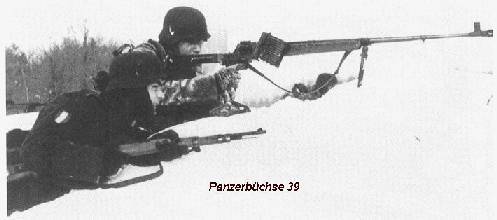
A new gun has become not only safer, but also easier. In a combat position, the PzB 39 weight was 12,1 kg. All other characteristics remained at the level of the previous sample. At the same time, the PzB 39, like the PzB 38, had an extremely low resource, which was the price to pay for a record high initial bullet speed. In the original German 7,92 × 94 mm cartridges, the initial speed of a little more than 1200 m / s was achieved with a gas pressure of 2600 – 2800 kg / cm², while the life of the barrel was no more than 150 shots.
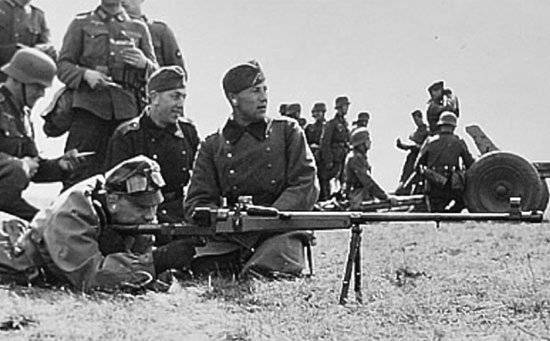
By the time of the attack on the Soviet Union, each German infantry company should have a section of seven men with three 7,92-mm anti-tank guns PzB 38 or PzB 39. One rifle was sometimes attached to each platoon of a company, but most often the rifles were concentrated and, in order to achieve at least some efficiency, they fired at one target.
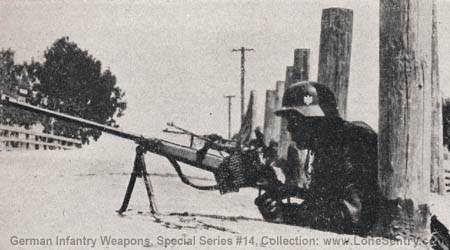
Serial production of PzB 39 was minimized in 1942, more than 39 000 PTR was transferred to the troops. Their use continued until the 1944 of the year, but already in the summer of the 1941 of the year it became clear that the 7,92-mm anti-tank guns were powerless against the new Soviet T-34 and KV tanks.
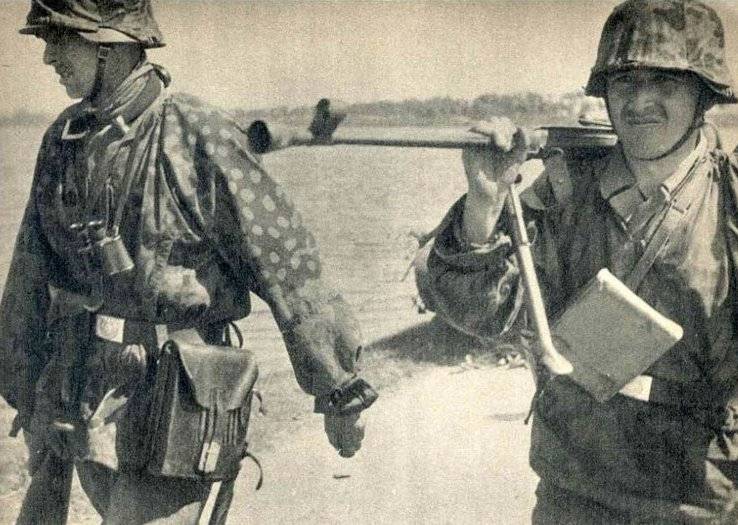
Another anti-tank gun that used the 7,92 × 94 mm cartridge was the PzB M.SS-41, designed by the Czech company Waffenwerke Brun (before the occupation of Czechoslovakia, Zbroevka Brno). When creating this PTR, Czech gunsmiths used their previous work.

In fact, this weapon was the first mass model created according to the bullpup scheme. The use of such a layout has significantly reduced the total length of the MFR. The box magazine on the 5 or 10 cartridges was behind the fire control handle. In addition, the Czechs have designed a very curious locking system - there was no rolling bolt in this weapon. During the reloading, the shooter did not need to remove his hand from the pistol grip, because with its help, when moving the grip forward-up, it would unlock the bolt and eject the spent cartridge case. Sending the next cartridge and locking the barrel was carried out with a coupling and occurred when the handle was moved back - down. On the pistol grip was assembled trigger mechanism and fuse.
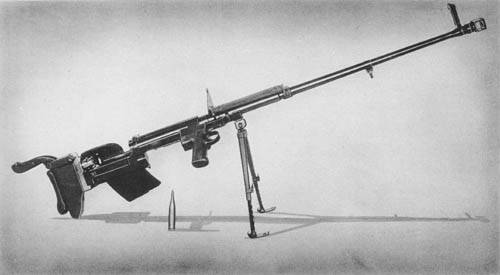
Sights were designed for firing at a range of 500 m. The barrel, receiver and butt PTR PZB M.SS-41 were located on the same axis. This, combined with the barrel length of 1100 mm, allowed for higher accuracy compared to PzB 38 or PzB 39. The use of a spring shock absorber, rubberized shoulder rest and single-chamber muzzle brake minimized recoil when shooting. At the same time, the PzB M.SS-41 MFR slightly exceeded other samples of the same caliber in armor penetration. Weapons weighing 13 kg had a length of 1360 mm. Combat rate reached 20 rds / min.
In terms of service and combat performance, the sample developed in the Czech Republic had advantages over the products of the German company Guslov Werke. However, the gun, which was put into service in the 1941 year, turned out to be more complicated and more expensive to manufacture than well mastered in the PzB 39 troops. For this reason, around 2000 PzB M.SS-41 was released, which were mainly used in the SS infantry units. A number of sources state that the PzB M.SS-41 developed the single-shot 15-mm PTR PzB 42, which was produced in a small series and was used in limited quantities by the Waffen SS. The total length of the anti-tank gun was 1700 mm, weight - 17,5 kg.
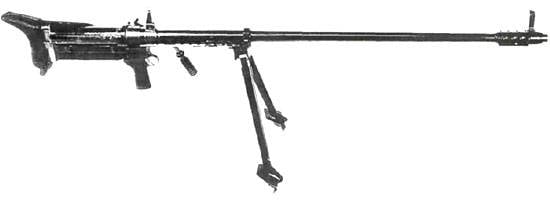
In the PzB 42 PTR, the Czech cartridge 15x104 Brno was used with an initial speed of a bullet with a mass of 75 g - 850 m / s. At a distance of 100 m he punched 28 mm armor. However, for 1942, such armor penetration characteristics were considered insufficient and weapons were not launched into mass production.
After the occupation of Poland, the Germans got several thousand Polish anti-tank guns Karabin przeciwpancerny wz. 35. Like the German PTR, this weapon had a caliber of 7,92-mm, but the Polish cartridge was longer. In the sleeve length 107 mm fit 11 g of smokeless powder. In the barrel length 1200 mm, the bullet weight 14,58 g accelerated to 1275 m / s. Muzzle Energy - 11850 J.

At the same time, lead-core bullets were used against armored vehicles, which, thanks to high speed at a distance of 100 m, could penetrate 30 mm armor plates mounted at right angles, the hole diameter after penetration exceeded 20 mm and all formed fragments penetrated the armor. Subsequently, the Germans used carbide core bullets. This increased the armor penetration, but the diameter of the hole and the armored damage effect became smaller.
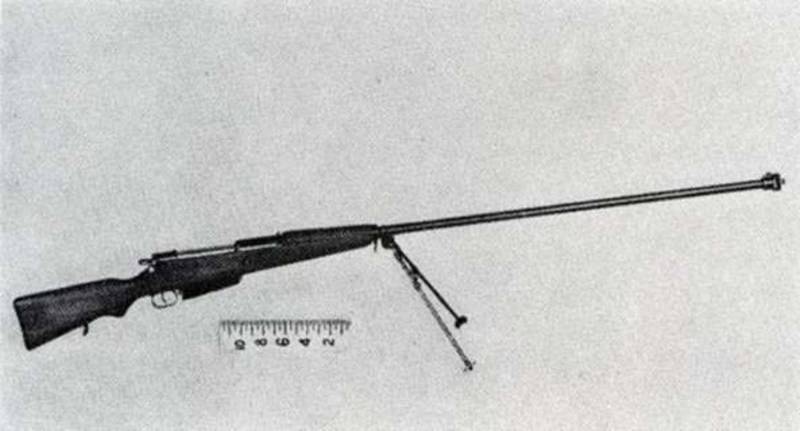
Anti-tank gun wz. The 35 did not shine with original technical solutions and in fact was a larger Mauser rifle. PTR recharged manual longitudinally sliding bolt with a turn, food was carried out from the store for four rounds. Shooting was conducted with an emphasis on bipod, sights allowed firing at a distance of up to 300 m. Resource barrel was 300 shots. Combat rate - up to 10 rds / min. Length - 1760 mm, weight in the combat position - 10 kg.
In Germany, the Polish PTR was adopted under the designation PzB 35 (p). Several hundred anti-tank guns of this type were used in May 1940, against French tanks. The gun showed quite good results when firing at the embrasures of the bunkers and billets.
After the French campaign in the Wehrmacht infantry units, there were about 800 PTR PzB 35 (p), which were operated on a par with their own guns PzB. 38 / 39. A number of captured Polish ATGMs were transferred to the allies: Hungary, Italy, Romania and Finland, who also used them in battles on the Eastern Front.
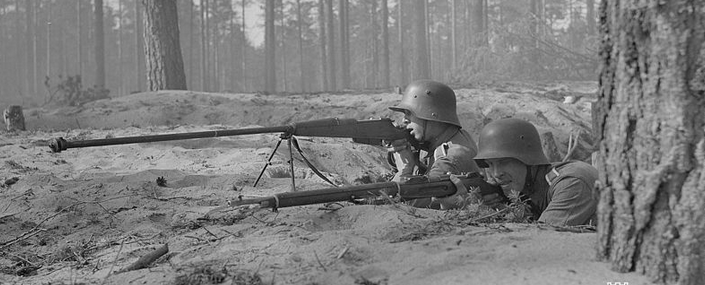
Without exception, 7,92-mm anti-tank rifles had a very high initial velocity of the bullet, which in turn led to rapid wear of the rifling rifles. The use of small-caliber high-speed cartridge allowed to reduce the weight and dimensions of the weapon, but at the same time limited armor penetration. Bullets weighing no more than 15 g with an initial speed of a little more than 1200 m / s when fired at point-blank, at best, pierced 40 mm vertically mounted armor plates.
Such characteristics of armor penetration allowed to fight light tanks and armored vehicles. However, tanks with anti-sheath 7,92-mm PTR were “too tough”, which eventually led to the removal of “small-caliber” anti-tank guns from production and their replacement in the troops with more effective anti-tank weapons.
At the beginning of 20, the German concern Rheinmetall Borzing AG acquired the Swiss company Solothurn Waffenfabrik, which was later used to develop and manufacture weapons in circumvention of the Versailles Treaty. In 30-s, a universal 20-mm system was created in the design office of the German concern based on the 20-mm cannon designed by Heinrich Ehrhardt, German gunsmith Louis Stang. It could be used for arming aircraft, as an anti-aircraft gun, and for installation on armored vehicles. However, to avoid accusations of violating the conditions of the Treaty of Versailles, new weapons began to be produced in Switzerland. In 1932, one of the variants of the 20-mm gun was a heavy, self-loading, shop-gun Soloturn S 18-100 anti-tank rifle, designed to use the 20 × 105 mm cartridge. Automation heavy PTR worked on the principle of recoil of the barrel with its short stroke. The trigger mechanism allowed the maintenance of only a single fire. The weapons were supplied with ammunition from detachable box magazines with a capacity of 5-10 shells, which are attached horizontally to the left. The mechanical sights consisted of an open, adjustable sector-type sight, designed for a distance of up to 1500 m or an optical sight with a factor of × 2,5. PTR firing was carried out with a bipedal bipod, the barrel was equipped with a muzzle brake. For additional support and fixation of the weapon in a certain position, a height-adjustable support-monopod was mounted under the shoulder rest.
The anti-tank rifle at the time of creation had good armor penetration. At a distance of 100 m, 20-mm armor-piercing projectile with a mass of 96 g with an initial speed of 735 m / s normal pierced through 35 mm armor, and with 300 m - 27 mm armor. The combat rate of fire was 15-20 rds / min. However, the size and weight of the weapon was excessive. With a total length of 1760 mm, the mass of the MFR in a combat position reached 42 kg. Due to the heavy weight and strong recoil, the weapon was not popular among the troops. However, a number of the Soloturn S 18-100 MFR was used during hostilities on the Eastern Front. To pierce the armor of the new Soviet tanks 20-mm anti-tank gun in most cases could not, but it is well established itself when firing at firing points and in street battles.
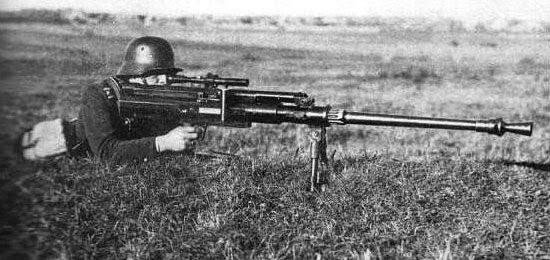
In the second half of the 30-ies, the engineers at Solothurn Waffenfabrik decided to increase the effectiveness of the anti-tank rifle by remaking it for more powerful 20 × 138 mm projectiles. The new MFR, which received the designation Solothurn S18-1000, was longer, the main external difference from the early model was the multi-chamber muzzle brake. With a total length of 2170 mm, the mass of the MFR without ammunition was 51,8 kg. Due to the increased length of the barrel and a larger volume of powder charge in the sleeve, the initial velocity of the armor-piercing projectile increased to 900 m / s. At a distance of 100 m, a shell at right angles punched 40 mm armor.
The development of Solothurn S18-1000 was the model Solothurn S18-1100, the main difference of which was the possibility of firing bursts. In this regard, the weapons adapted round shops on 20 shells from the anti-aircraft machine Flak 18. In the Wehrmacht PTR Solothurn S18-1000 received the designation PzB.41 (s), and Solothurn S18-1100 - PzB.785. Since carrying weapons over long distances was too burdensome to calculate, and the return was excessive, there was an option installed on a special two-wheel machine.
After a combat debut in Russia, it turned out that a heavy 20-mm anti-tank gun is not able to effectively deal with medium-sized T-34 tanks, and its weight and dimensions do not allow accompanying troops on the offensive and using it as a fire support weapon. For this reason, in 1942, the main part of the 20-mm PTR was transferred to North Africa, where they were not without success used against British and American light armored vehicles. A number of PzB.785 Germans installed in the bunkers on the Atlantic coast. In addition to the German army, the Soloturn PTR was used in the armed forces of Bulgaria, Hungary, Italy, Switzerland and Finland.
During the Second World War, the German armed forces also used the Danish 20-mm “universal machine guns” M1935 Madsen. This weapon, which was in fact a rapid-fire small-caliber gun, was created to combat armored vehicles at medium and short distances and with air targets at low altitudes. The machine gun was designed for 20 × 120 mm caliber cartridge, and functioned according to the old Madsen machine gun with a short barrel stroke and a swinging bolt. The air cooling barrel was supplied with a muzzle brake. This weapon could be used in various versions. Basically, the body of the “machine gun” with a mass of 55 kg was mounted on wheeled or tripod machines, which allowed firing at both ground and air targets. Mass of universal installation on a tripod machine - 260 kg.
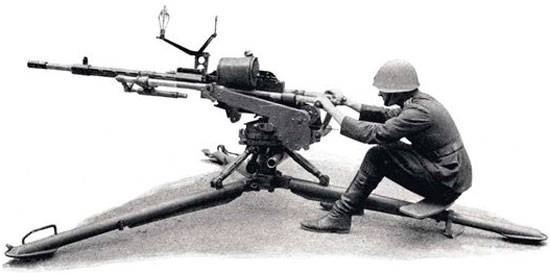
An armor-piercing projectile with an initial speed of 770 m / s, at a distance of 100 m punched 40 mm armor, at a distance of 500 m the armor penetration was 28 mm. The maximum firing range at ground targets is 1000 m. The installation was powered from magazines with a capacity of 10, 15, 40 or 60 shells. Rate of fire - 450 rds / min, practical rate of fire - 150 rds / min.
In addition to 20-mm installations on wheeled and tripod machines, the Germans got several dozen “automatic anti-tank guns” in the form of trophies, some of which were mounted on motorcycles.
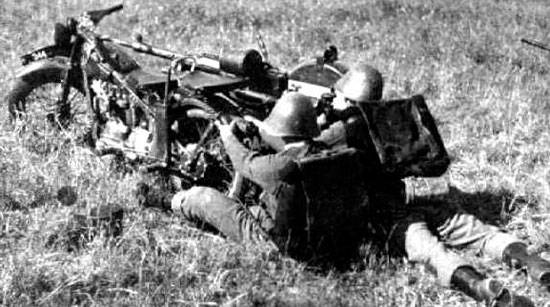
In the infantry version of the 20-mm PTR Madsen 1935 rested on a two-legged bipod, in the rear of the receiver there were: an additional, height-adjustable support and shoulder rest. On the barrel of the weapon is a powerful muzzle brake.
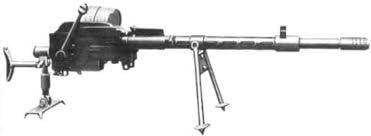
Although the switch of the fire mode of the anti-tank gun allowed the possibility of firing in bursts, taking into account the strong recoil and low stability, the fire was mostly single. At the same time, the practical rate of fire was 10-15 shots / min. The mass of weapons in the version of the PTR, without cartridges exceeded 60 kg There is considerable evidence that the Germans used 20-mm universal installations for air defense purposes. However, the fate of the 20-mm PTR Madsen 1935 is unknown. It can be assumed that all of them were lost on the Eastern Front, without having a noticeable effect on the course of hostilities.
In addition to Czech, Polish and Danish samples, the German armed forces used British and Soviet anti-tank guns in significant quantities. In the spring of 1940, a large number of different weapons were abandoned by the British at Dunkirk in France. Among the many trophies were several hundred 13,9-mm PTR Boys Mk I.
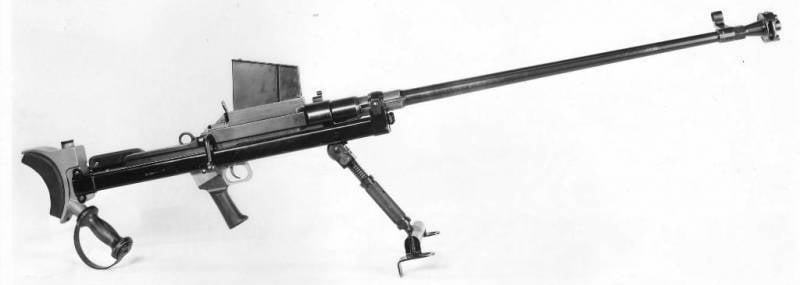
The British model in its characteristics did not stand out among the anti-tank rifles designed in the middle of the 30-s. Weapons with a total length of 1626 mm, without ammunition weighed 16,3 kg. A five-round magazine was inserted from above, and therefore the sights were shifted to the left relative to the barrel. They consisted of a fly and a diopter sight with installation on the 300 and 500 m mounted on a bracket. The weapon was reloaded manually by a longitudinal sliding gate with a turn. Practical rate of fire - up to 10 rds / min. The shooting was carried out with the support on the T-shaped folding bipod, on the butt there was an additional support-monopod.
For the “Boyce” PTR adopted in service in Great Britain in 1937 years, ammunition with two types of bullets was used. Initially used for shooting cartridge with a bullet, which had a hardened steel core. A bullet with a mass of 60 g left the barrel with an initial speed of 760 m / s and at a distance of 100 m at right angles could penetrate 16 mm steel armor sheet of medium hardness. 47,6 g bullet with a tungsten core possessed higher armor penetration. It accelerated to a speed of 884 m / s, and at a distance of 100 m at an angle 70 ° pierced 20 mm armor. Thus, 13,9-mm anti-tank guns could only be effective against light tank and armored vehicles.
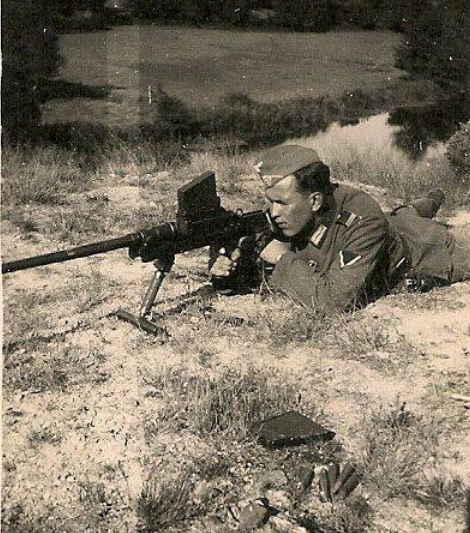
In 1940, the Boyes anti-tank gun was taken into service in the German army under the designation 13.9-mm Panzerabwehrbüchse 782 (e) and was actively used in the initial period of the war on the Eastern front. Also, these PTR were available in the Finnish army.
Beginning with 1942, the Germans used 14,5-mm PTR design by V.А. Degtyarev and S.G. Simonov. PTRD-41 received the official designation Panzerbüchse 783 (r), and PTRS-41 - Panzerbüchse 784 (r).
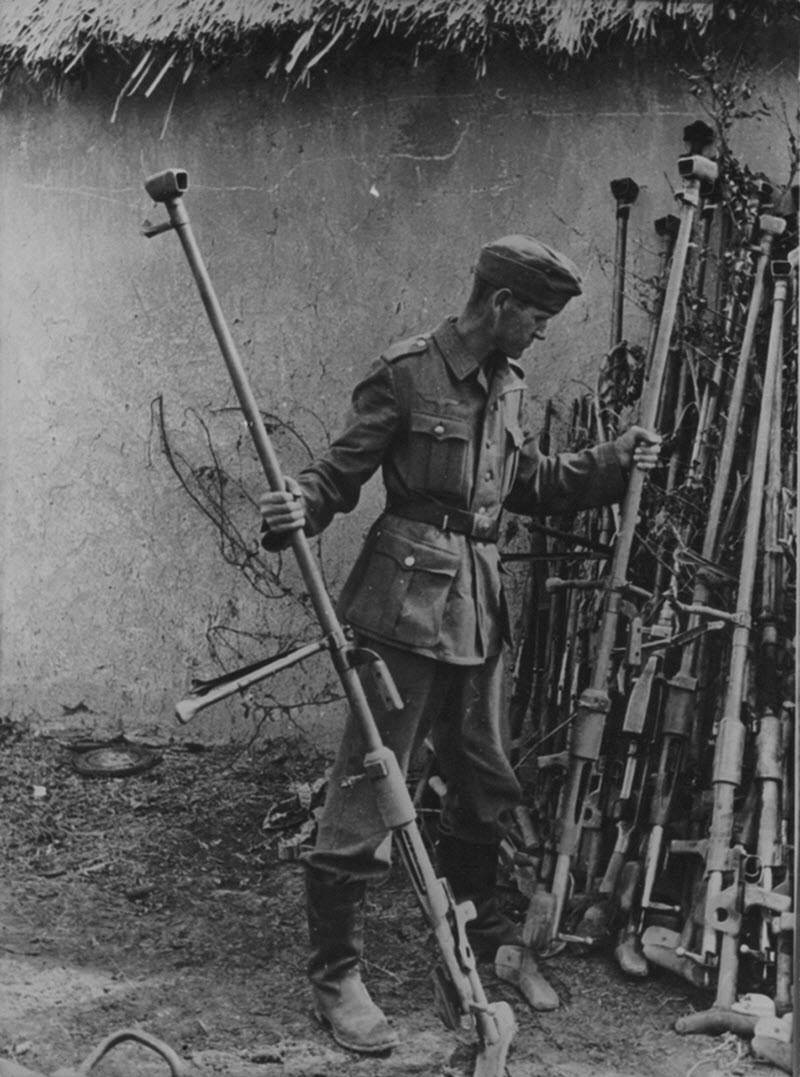
Compared to the British ATG “Boys”, Soviet guns had higher combat characteristics. Single-shot PTRD-41 chambered for 14,5 x114 mm had a length of 2000 mm and a mass of 17,5 kg. At a distance of 100 m, the armor penetration rate of a BS-41 bullet with a tungsten carbide core was normally 40 mm, with 300 m it was able to penetrate 30 mm armor. However, more bullets were bullets with BS-32 and BS-39 armor-piercing incendiary bullets, which had a hardened core made of tool steel U12A and U12XHA. At a range of 300 m, their armor penetration was 22-25 mm. Combat rate of fire PTRD-41 - 8-10 rds / min. Battle calculation - two people. The self-loading PTRS-41 worked according to the automation scheme with a powder gas outlet, had a magazine on 5 cartridges, and was significantly heavier than Degtyaryov's anti-tank gun. The mass of weapons in a combat position was 22 kg. However, Simonov's anti-tank rifle was twice as fast as the PTD-41 - 15 rds / min.
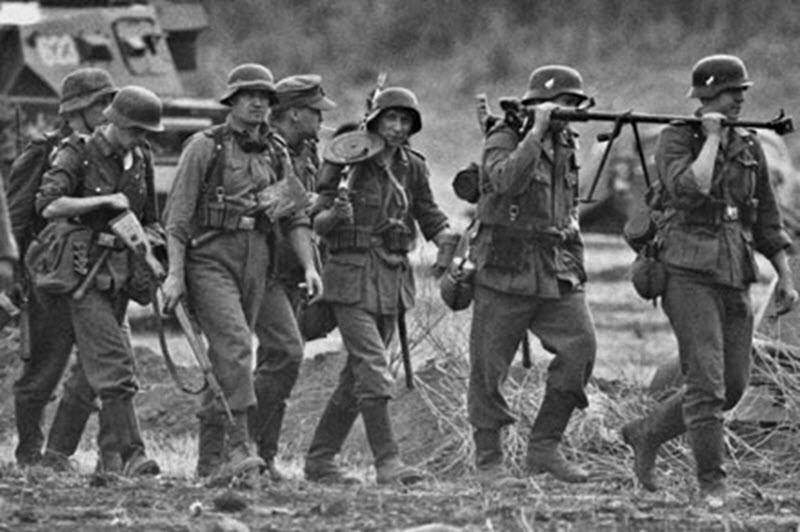
In total, the Germans dare to capture several thousand Soviet PTR. In the spring of the 1942 on the Eastern Front of the Year, the newly formed infantry units and those taken out for re-formation began to receive PzB 783 (r) in appreciable quantities, which were actively used in offensive battles in the southern direction. Considering the fact that at that time the Red Army had a significant number of old BT and T-26 tanks, as well as light T-60 and T-70 lightweight T-14,5 TTRMs created in the initial period of the war, showed good results. Particularly active anti-tank guns of Soviet production used parts of the Waffen SS. In the second half of the war, after the transition of Germany to strategic defense, the number of captured PTRs dropped sharply, and there was not always enough ammunition for them. However, 14,5-mm anti-tank guns remained in service with the German infantry until the last days of the war.
As production in the USSR increased with anti-shell armor, the role of anti-tank guns fell to a minimum. In connection with the growth of armored vehicles, an increase in the caliber and mass of the MFR occurred, the largest samples of anti-tank guns came very close to light artillery systems.
In 1940, the production of the “anti-tank gun” 2,8 cm schwere Panzerbüchse 41 began at the factory of the Mauser company in Oberndorf-on-Neckar, which by all indications could be attributed to light anti-tank guns. The heavy PTR s.PzB.41 was created on the order of the light-infantry and mountain units of the Wehrmacht, as well as the Luftwaffe parachute troops. For actions on highly rugged terrain, during the landing of airborne and naval assault forces, anti-tank systems were required that were not inferior in efficiency to 37-mm PaK 35 / 36 X-guns, but with much better mobility, the ability to be disassembled into parts and suitable for carrying in packs.
After analyzing all possible options, the designers of the company "Renmetall" to increase the armor penetration and while maintaining a small caliber decided to use a conical bore. The inventor of a weapon with a tapered bore is German engineer Karl Puff, who patented a gun with this type of barrel and a special bullet for him in 1903. In 20-30, the German inventor Hermann Gerlich, who conducted a series of experiments at the German Test Institute for Handguns in Berlin, was closely involved in this topic. Experiments have shown that the use of a conical bore in combination with special bullets with wrinkled belts can dramatically increase the initial velocity of the projectile, and as a result armor penetration. The downside of weapons of this type was the difficulty of manufacturing a rifled barrel and the need to use expensive and scarce tungsten in armor-piercing shells.
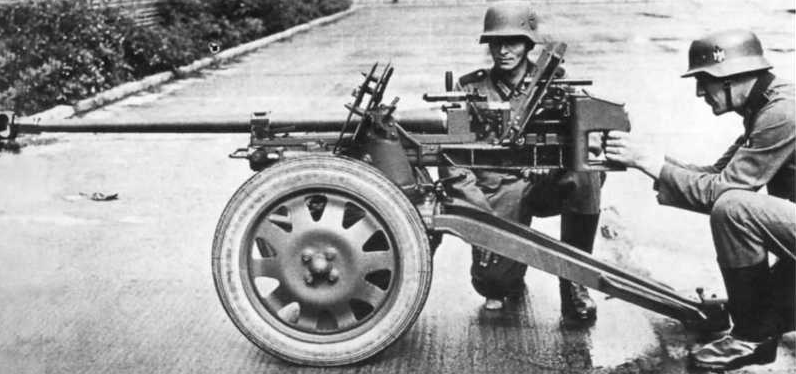
In the summer of 1940, an experimental batch of 30 heavy PTRs was tested at the Kummersdorf test site, after which the weapons were put into service. PTR s.PzB.41 had a rifled monoblock barrel with a muzzle brake weighing 37 kg. A special feature of the trunk was the presence of a conical part - at its beginning, the diameter of the trunk along the rifling fields was 28 mm, at the end, at the muzzle, 20 mm.
This design ensures the preservation of increased pressure in the barrel bore over most of the projectile acceleration area and, accordingly, the achievement of high initial velocity. The pressure in the barrel when fired reached 3800 kgc / cm². The price for a high initial speed was the reduction of the barrel resource, which did not exceed 500 shots. Since recoil energy was very significant, recoil devices were used. The damping of the barrel oscillations during firing and aiming took place with the help of a hydraulic damper. An optical sight from the 37-mm PTO PaK 35 / 36 and a mechanical open sight with the whole front sight were used for aiming at the target. The maximum range of aimed shooting was 500 m. Combat firing rate - 20 shots / min. Weight in the combat position on the wheel machine - 227 kg.
A feature of the gun is the possibility of firing, both from the wheels, and directly from the lower machine. The wheel travel could be removed in 30 — 40 seconds, and the calculation is located in the prone position. This greatly facilitated the masking and use of s.PzB.41 in the trenches of the first line of defense. If necessary, the gun can be easily disassembled into 5 units weighing 20-57 kg.
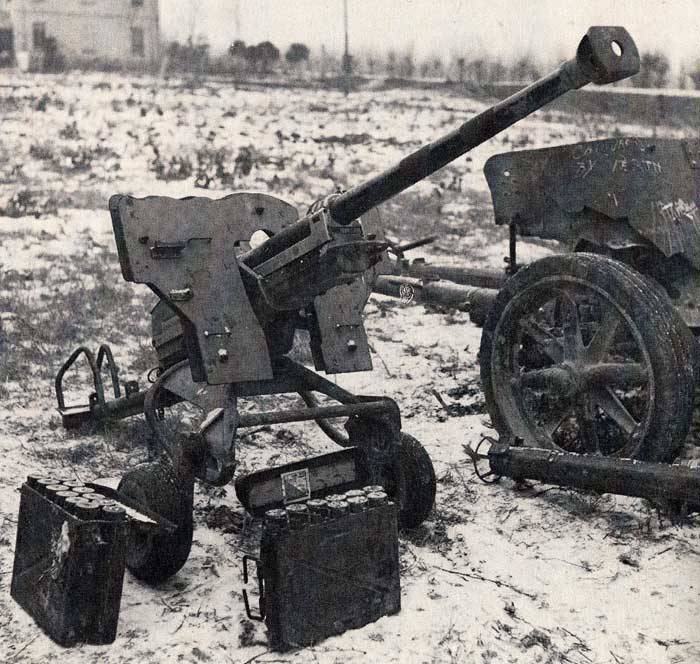
For amphibious and mountain parts produced a lightweight version of the total weight of 139 kg on small rubber wheels. The system of vertical and horizontal guidance 28 / 20-mm system did not have, the aiming was carried out by turning the rotating and swinging parts of the gun manually. Apparently, proceeding from this feature, s.PzB.41 in Germany was attributed not to artillery guns, but to anti-tank guns.
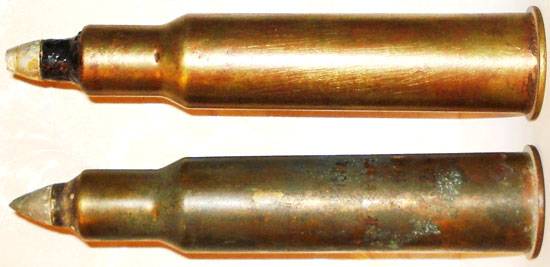
The armor penetration of s.PzB.41 for such a small caliber was very high. The 2,8 cm Pzgr.41 subcaliber projectile with 124 g mass was accelerated in the barrel to 1430 m / s. According to German data, at a distance of 100 m at a meeting angle of 60 °, a shell pierced 52 mm armor, and at a distance of 300 m - 46 mm. Permeability when hit at right angles was 94 and 66 mm, respectively. Thus, the heavy PTR s.PzB.41 at a short distance could successfully deal with medium tanks. However, the extensive production of heavy 28 / 20-mm PTR was hampered by the complexity of manufacturing a conical shaft and the lack of tungsten for armor-piercing cores. The mass production of such tools required the highest industrial culture and the most advanced metalworking technologies. Until the second half of the 1943, 2797 heavy PTR s.PzB.41 in Germany and 1602 thousand armor-piercing shells were manufactured in Germany.
Heavy PTR s.Pz.B.41 were in service in the infantry, light infantry, motorized, mining and Jaeger divisions of Wehrmacht and SS troops, as well as in the parachute and airfield divisions of the Luftwaffe. Part of the guns entered the individual anti-tank divisions. Although the production of s.Pz.B.41 ceased in 1943, they were used until the end of hostilities. The latest cases of combat use refer to the Berlin operation.
To be continued ...
Based on:
http://www.jaegerplatoon.net/AT_GUNS1.htm
http://www.landships.info/landships/artillery_articles/Ig_Krupp_l16.html
http://pro-tank.ru/tanki-v-bou/930-infantry-vs-tanks-in-ww2-germany
https://saint-petersburg.ru/m/arsenal/old/254777/
http://www.cruffler.com/Features/FEB-02/historic-february02.html
http://www.smallarmsreview.com/display.article.cfm?idarticles=1179
https://warspot.ru/12445-s-vintovkoy-protiv-tanka
http://fritzwaffen.blogspot.com/2010/04/2cm-panzerbuchse-785-s-solothurn-s18.html
http://ww2history.ru/3859-nemeckoe-2820-mm-tjazheloe-protivotankovoe-ruzhe.html
https://www.onwar.com/weapons/afv/indexes/countryIndex.html
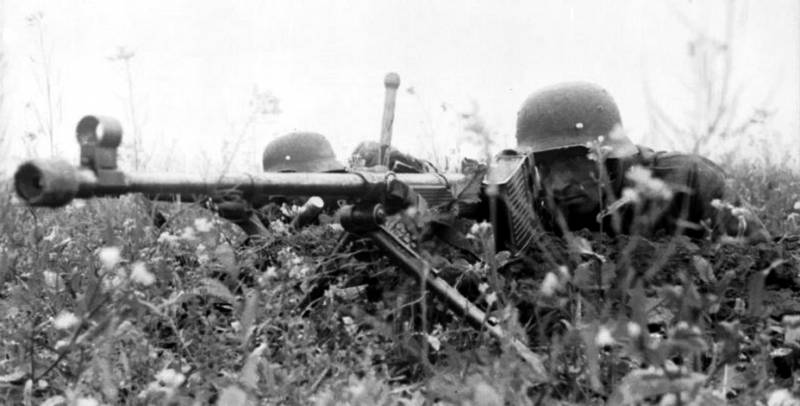
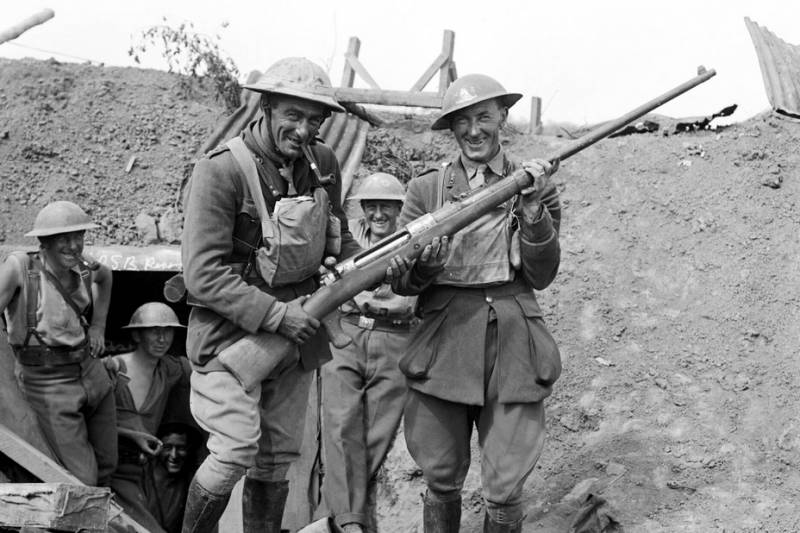
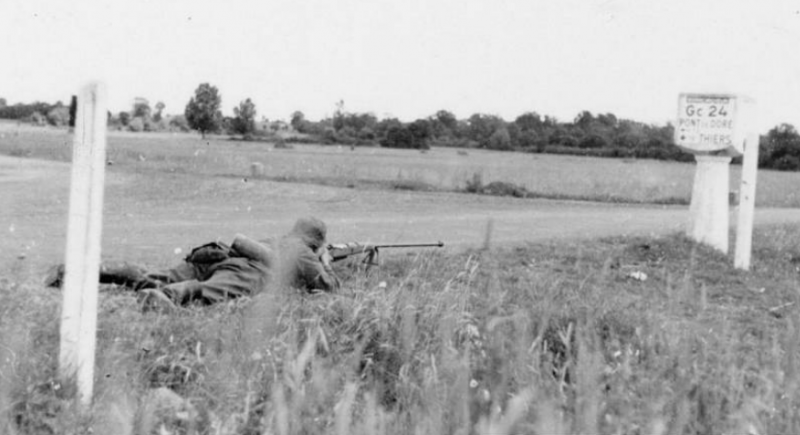
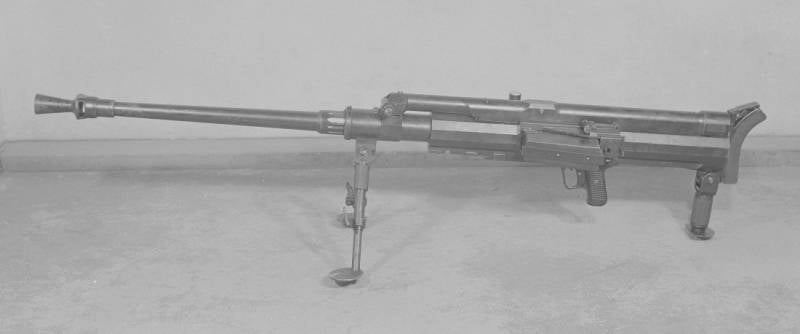
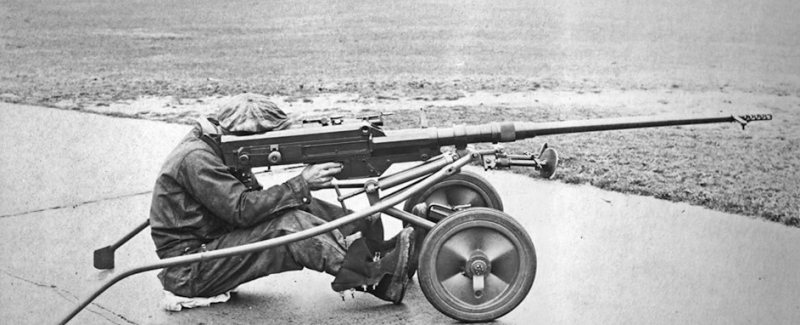
Information